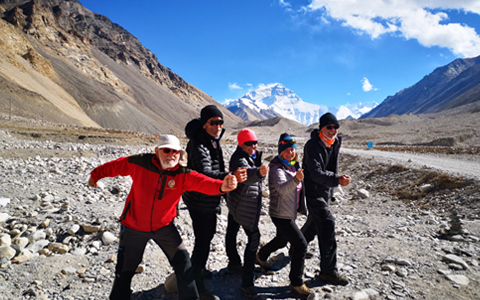Among all the ways to reach Lhasa, the Tibet train offers the most thrilling experience, passing through breathtaking landscapes over thousands of miles. Curious about the trains to Lhasa and their schedules? Read this article to discover all your options for traveling to Tibet by train and make an informed decision about the best route for your journey.
Train to Lhasa from Beijing: Departing Daily (Duration: 39h 43m)
The Tibet train from Beijing to Lhasa departs every day at 19:53 and runs for around 39 hours and 43 minutes before reaching the plateau. It will pass through several northern provinces before reaching Xining to start the real ride on the Qinghai-Tibet Railway. The train arrives at Lhasa Railway Station on the third day at noon.
If you want to shorten the journey from Beijing to Lhasa, you can first fly to Xining and then take the train from Xining to Lhasa. Alternatively, you can board a high-speed train to Xi’an and then transfer to the Xi’an to Lhasa train.
Train to Lhasa from Shanghai: Departing Daily (Duration: 44h 32m)
The train from Shanghai to Lhasa leaves once every day, at 18:33 from Shanghai Railway Station, and arrives in Lhasa at 15:05. The train runs across 8 provinces, passing major cities such as Suzhou, Nanjing, Zhengzhou, and Xi’an before reaching Xining, and then continues toward Lhasa.
Taking this train route, you'll witness a variety of landscapes, starting from the busy eastern coast, moving through central China, and ending at the majestic Tibetan Plateau in the west. But the most stunning views come as the Tibet train travels from Xining to Golmud and continues on to Lhasa.
 Beautiful scenery along the Qinghai Tibet Railway
Beautiful scenery along the Qinghai Tibet RailwayTrain to Lhasa from Xining: 6 Daily Departures (Duration: 21h 30m)
The train from Xining to Lhasa has the shortest duration and also departs most frequently, operating a total of six times per day. And Xining serves as the starting point of the Qinghai-Tibet Railway, allowing you to appreciate the unparalleled plateau landscapes right after boarding the train.
Taking around 20 hours to 21.5 hours, the train from Xining passes through Delingha, Golmud, Nagchu, before reaching Lhasa. For tourists with limited time, you can first take a flight to Xining and then enjoy the train to Lhasa. This allows you to shorten the long train ride while also not missing out on the railway scenery.
 Train from Xining to Lhasa has the shortest duration and also departs most frequently.
Train from Xining to Lhasa has the shortest duration and also departs most frequently.Train to Lhasa from Chengdu: Departing Every Other Day (Duration: 34h 30m)
The train from Chengdu to Lhasa leaves every other day at 21:11 and arrives in Lhasa on the third day. It's a journey of about 34 hours and 30 minutes covering 3070 km. Along the way, you'll travel northward and then westward, passing through cities like Lanzhou, Xining, Delingha, and Golmud.
 It's convenient to make a stopover in Chengdu before you take a train to Lhasa.
It's convenient to make a stopover in Chengdu before you take a train to Lhasa.If you're planning to travel from Chengdu to Lhasa by train, you are making the right choice. Chengdu is easy to reach with direct flights from both inside China and overseas, so it's convenient for you to make a stopover here. Plus, Chengdu itself has delicious food, beautiful scenery, and adorable pandas, which can be a great experience for you before heading to Lhasa.
Train to Lhasa from Xi’an: 3 Daily Departures (Duration: 30h 24m)
Currently, there are three direct trains from Xi’an to Lhasa. Two of them, Z265 and Z165, run daily, starting respectively from Guangzhou and Shanghai. The other one is Train No. Z917, which originally departs from Xi’an Railway Station but runs every other day.
The journey from Xi’an to Lhasa generally takes about 30 hours, making it a shorter trip. Along the way, you can enjoy the beautiful scenery of the Qinghai-Tibet Line without the journey being too lengthy. However, it's important to note that Xi'an city is a popular tourist destination, so getting tickets for the train to Lhasa during peak seasons can be quite challenging. It's recommended to book your tickets in advance.
 Xi'an city is a popular tourist destination, so getting tickets for the train to Lhasa can be challenging.
Xi'an city is a popular tourist destination, so getting tickets for the train to Lhasa can be challenging.Train to Lhasa from Guangzhou: Departing Daily (Duration: 53h 2m)
The train from Guangzhou to Lhasa departs every day and has the longest duration, spanning over 53 hours. It starts at 9:15 on the first day and arrives at 14:17 on the third day. Along the route, the train passes through Changsha, Zhengzhou, Xi’an, Lanzhou, then Xining, Golmud, and finally Lhasa.
Even though the train journey from Guangzhou to Lhasa is lengthy, it offers you the chance to embrace the relaxed pace of traveling across much of China in one trip. From the south to the north, from the east to the west, you'll witness the landscape transform from the scenic Pearl River Delta to the vast and remote inland regions of the Qinghai-Tibet Plateau.
 Guangzhou to Lhasa train has the longest duration.
Guangzhou to Lhasa train has the longest duration.Train to Lhasa from Chongqing: Departing Every Other Day (Duration: 33h 45m)
The Chongqing to Lhasa train departs every other day, offering an alternative to the Chengdu to Lhasa route. These two trains alternate their departures daily and cover almost the same railway route. The journey from Chongqing to Lhasa by train takes about 33 hours.
The train journey from Chongqing to Lhasa is also very popular. If you're keen on experiencing Chongqing's famous night view or trying its delicious hot pot, or if you'd like to enjoy a Yangtze River cruise before heading to Tibet, this railway route is a great choice.
Train to Lhasa from Lanzhou: 5 Daily Departures (Duration: 23h 1m)
The Lanzhou to Lhasa train offers one of the quickest journeys to Tibet by train. These trains are all through trains, meaning they pass through Lanzhou. Since trains from Shanghai, Guangzhou, Beijing, Xi'an, Chongqing, and Chengdu to Lhasa all go through Lanzhou, you have plenty of options. The trip from Lanzhou to Lhasa only takes 24 hours, so you won't have to endure a long journey.
Train to Lhasa from Nyingchi: the Only Bullet Train to the Plateau
In addition to the trains from mainland China to Lhasa, there's a bullet train from Nyingchi to Lhasa on the plateau. This route spans about 435 kilometers and runs twice daily, taking roughly 4 hours to reach its destination.
 Bullet train from Nyingchi to Lhasa
Bullet train from Nyingchi to LhasaFor tourists entering Tibet through Nyingchi, this train journey is a must-try. Along the route, you'll encounter the stunning landscapes of eastern Tibet, including the Yarlung Zangbo Grand Canyon, the picturesque Nyang River, and more. It's a fantastic way to experience the beauty of the region while traveling comfortably by train.
Is There a Train to Lhasa from Kathmandu?
Currently, there is no train available from Kathmandu to Lhasa. The China-Nepal Railway is in the planning stages, and part of the railway has been completed. You can either take a flight from Kathmandu to Lhasa or travel overland via the Gyirong Port. The flight takes about 1 hour and a half, while the overland drive will be a journey of around eight days, allowing you to visit the highlighted sites along the route.
Travel Tips for Taking a Train to Lhasa
1. Ensure you have your Tibet Travel Permit before departure. It's crucial for taking the train to Lhasa; without it, you cannot board the train. And we can help you to obtain the permit for free when you book your Tibet tour with us.
2. Book your Tibet train ticket early. Tickets sell out quickly, especially during peak seasons. Booking opens 15 days before travel, so secure your tickets promptly. If unable to get a ticket to Lhasa, consider taking a return train from Lhasa to mainland China after your Tibet tour. You'll also enjoy scenic views of the Qinghai-Tibet railway during the daytime.
3. Bring your own food for the train journey. Unsure about onboard food options? Bring pot noodles and packaged foods. Boiling water is available for free onboard the train, suitable for preparing meals or beverages.
Conclusion
Traveling to Lhasa by train is a popular choice among tourists. Trains departing from various cities across China offer a wonderful journey along the renowned Qinghai-Tibet Railway. If you're unsure about which train route to take or have any questions about traveling to Lhasa by train, please don't hesitate to contact us.


























 Beautiful scenery along the Qinghai Tibet Railway
Beautiful scenery along the Qinghai Tibet Railway Train from Xining to Lhasa has the shortest duration and also departs most frequently.
Train from Xining to Lhasa has the shortest duration and also departs most frequently. It's convenient to make a stopover in Chengdu before you take a train to Lhasa.
It's convenient to make a stopover in Chengdu before you take a train to Lhasa. Xi'an city is a popular tourist destination, so getting tickets for the train to Lhasa can be challenging.
Xi'an city is a popular tourist destination, so getting tickets for the train to Lhasa can be challenging. Guangzhou to Lhasa train has the longest duration.
Guangzhou to Lhasa train has the longest duration. Bullet train from Nyingchi to Lhasa
Bullet train from Nyingchi to Lhasa










Ask a Quick Question